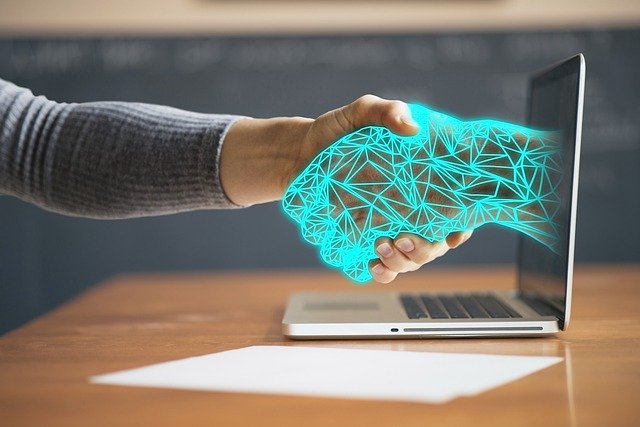Prosthetic technology has always been focused on restoring lost function, helping amputees regain mobility and independence. But what if prosthetics could do more? What if they could enhance human abilities beyond natural limits? The next frontier of prosthetic development is moving from restoration to augmentation, unlocking superhuman strength, precision, and sensory perception.
Between 2025 and 2030, advancements in AI, robotics, and neural integration will make prosthetic limbs more than just replacements. They will be tools for pushing human potential further than ever before, allowing users to lift heavier objects, react faster, and interact with the digital world in ways we never imagined.
At Robobionics, we are at the forefront of these innovations, ensuring that prosthetic technology is not just about regaining what was lost—but about redefining what’s possible. In this article, we explore the future of prosthetic enhancements that go beyond human limits, shaping a new era of mobility, strength, and sensory expansion.
1. Superhuman Strength: How Prosthetics Will Redefine Physical Limits

For years, prosthetic limbs have been designed to mimic human strength, helping users perform everyday tasks with natural force and control. But with advanced robotics, AI-powered motion optimization, and next-generation materials, prosthetic limbs will soon surpass biological strength, endurance, and precision.
One of the biggest breakthroughs is electromechanical actuators, which use high-efficiency motors and AI-driven torque control to enable unmatched power and lifting capacity. Unlike human muscles, which experience fatigue and strain, next-gen prosthetic limbs will be able to lift heavy objects effortlessly, sustain continuous activity, and adjust grip strength dynamically without physical exhaustion.
By 2030, smart prosthetics will allow users to perform physical feats beyond human limits, from lifting hundreds of kilograms with minimal effort to maintaining steady grip force without shaking or instability. This will revolutionize industries like construction, manufacturing, and emergency response, where workers will rely on enhanced prosthetic arms and exoskeletons to perform tasks that were once impossible.
2. Enhanced Speed and Reflexes: AI-Powered Instant Response
Human reaction time is limited by biological nerve transmission speeds, but prosthetic enhancements powered by artificial intelligence and high-speed processors will eliminate delay and optimize movement in real time. Future prosthetics will use neural integration and predictive AI algorithms to make movements faster, more fluid, and more responsive than human reflexes.
A key innovation in this field is AI-driven anticipation technology, which analyzes micro-movements, muscle tension, and environmental factors to predict user intent before the movement even happens. This means a prosthetic limb could adjust grip, reposition itself, or stabilize balance instantly, reducing reaction times to levels that even elite athletes cannot match.
By 2030, AI-enhanced prosthetics will allow users to respond to stimuli with near-instantaneous reflexes, improving athletic performance, workplace safety, and even military applications. Whether in sports, medicine, or defense, superhuman reaction speeds will redefine what the human body is capable of.
3. Multi-Functional Prosthetic Hands: Tools for Any Task
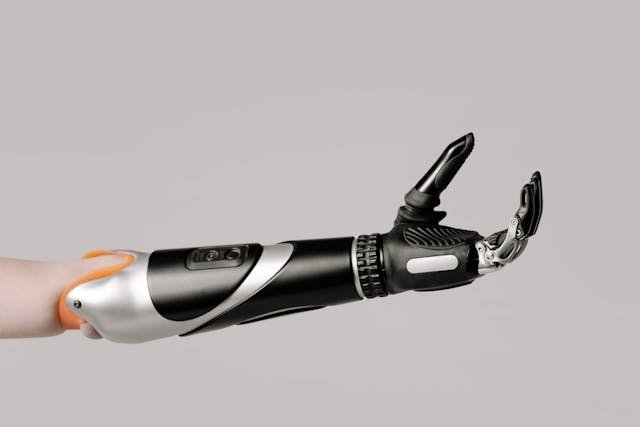
Traditional prosthetic hands are designed to grip, hold, and manipulate objects, but future prosthetic enhancements will go beyond the limitations of human anatomy, offering interchangeable tool systems that adapt to different needs. These next-gen prosthetic hands will feature modular designs, allowing users to swap between hands, tools, or specialized attachments instantly.
One major development is the integration of shape-shifting materials that can alter the form of a prosthetic hand on demand. Imagine a prosthetic limb that could reconfigure itself into a high-precision tool for surgery, a mechanical grip for construction work, or even a digital interface for controlling smart devices.
By 2030, prosthetic hands will not just replicate human functionality—they will surpass it, allowing users to customize their limbs for specific tasks, environments, or industries. This will create a new level of independence and efficiency, making prosthetic users more capable than ever before.
4. Advanced Sensory Perception: Seeing, Hearing, and Feeling Beyond Limits
One of the most exciting areas of prosthetic enhancement is sensory expansion, where artificial limbs don’t just restore lost sensation but extend human perception to new dimensions. Future prosthetic technologies will allow users to see infrared, hear ultrasonic frequencies, and detect changes in atmospheric pressure—capabilities that biological bodies could never achieve.
Haptic feedback technology is evolving to translate environmental data into sensory information, enabling prosthetic users to “feel” through vibrations, electrical stimulation, and neural signals. Imagine a prosthetic hand that can detect temperature changes before touching an object, sense textures beyond the human fingertip resolution, or even interpret electromagnetic fields.
By 2030, enhanced sensory prosthetics will turn users into “super-sensors,” enabling them to experience the world in ways that go far beyond human biology. These enhancements will be useful in fields like search-and-rescue operations, deep-sea exploration, and even space travel, where advanced sensory perception can mean the difference between life and death.
5. Neural Integration: Merging Prosthetics with the Human Brain
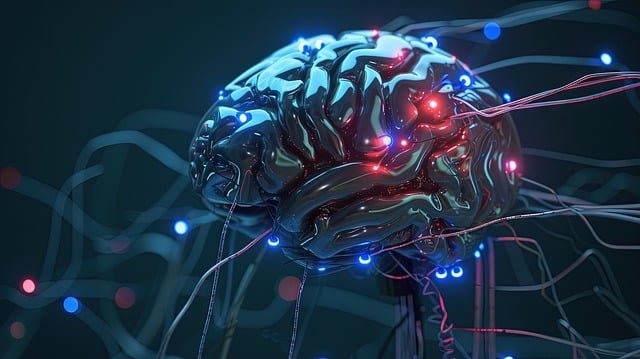
The future of prosthetics is direct brain control, where artificial limbs respond to thought commands just as naturally as biological ones. While brain-computer interfaces (BCIs) have already made progress, the next stage will be seamless neural integration, where prosthetic users control multiple advanced functions without conscious effort.
Emerging bioelectronic interfaces will enable two-way communication between the brain and prosthetic limbs, meaning not only will users control their artificial limbs with thought, but the limbs will also send sensory feedback back to the brain in real-time. This will create a fully integrated mind-body system, allowing for fluid, instinctive movement with zero lag.
By 2030, neural-integrated prosthetics will allow users to operate multiple limbs, control robotic exoskeletons, and even interact with digital interfaces using only their thoughts. This will blur the line between biology and technology, giving prosthetic users unprecedented abilities.
6. Digital Connectivity: Smart Prosthetics as Wearable Technology
Prosthetic limbs are no longer just mechanical extensions; they are becoming fully connected smart devices that integrate with the digital world. Future prosthetics will feature built-in AI assistants, real-time health monitoring, and direct access to smart home and workplace systems.
With 6G connectivity and cloud-based AI, prosthetic users will be able to control devices, open doors, adjust lighting, and interact with computers without needing separate controls. Prosthetic arms will function as human-machine interfaces, enabling seamless interaction between users and their digital environments.
By 2030, prosthetic limbs will be more than just mobility tools—they will be extensions of the digital world, allowing users to navigate technology effortlessly and stay connected in ways no natural limb could.
7. The Role of Biomechanics in Enhancing Prosthetic Efficiency

The foundation of any prosthetic limb is biomechanics—the study of movement, force, and structure in the human body. The next generation of prosthetic limbs will not only replicate natural human movement but will also optimize biomechanics for enhanced performance.
Future prosthetic enhancements will incorporate dynamic joint adaptation, allowing limbs to adjust stiffness, flexibility, and resistance based on activity. Whether walking, running, climbing, or lifting, the prosthetic limb will intelligently adapt in real time, ensuring maximum efficiency and energy conservation. This will be especially beneficial for athletes and active users, as it will allow longer endurance and reduced physical strain.
By 2030, biomechanically optimized prosthetics will allow users to perform activities with greater ease than a natural limb, making walking, running, and movement more fluid and efficient. These advancements will also prevent strain-related injuries, ensuring long-term comfort and functionality for prosthetic users.
8. Smart Materials: The Future of Self-Healing and Shape-Shifting Prosthetics
Traditional prosthetics rely on rigid materials like carbon fiber and metal, which provide durability but lack flexibility. The future of prosthetic development will see the introduction of smart materials that can change shape, self-heal, and adapt to different environments.
Self-healing materials, inspired by biological tissue regeneration, will allow prosthetic limbs to repair minor cracks or damages on their own, reducing the need for frequent repairs or replacements. Additionally, shape-memory alloys and programmable polymers will enable prosthetic limbs to change form based on the user’s needs, shifting from rigid to flexible for different activities.
By 2030, prosthetic limbs will be made from smart materials that offer durability, adaptability, and self-maintenance, ensuring longer lifespan and better performance. These materials will make prosthetics lighter, stronger, and more resilient, improving both function and user comfort.
9. Full-Body Prosthetic Exoskeletons: The Next Stage of Human Augmentation
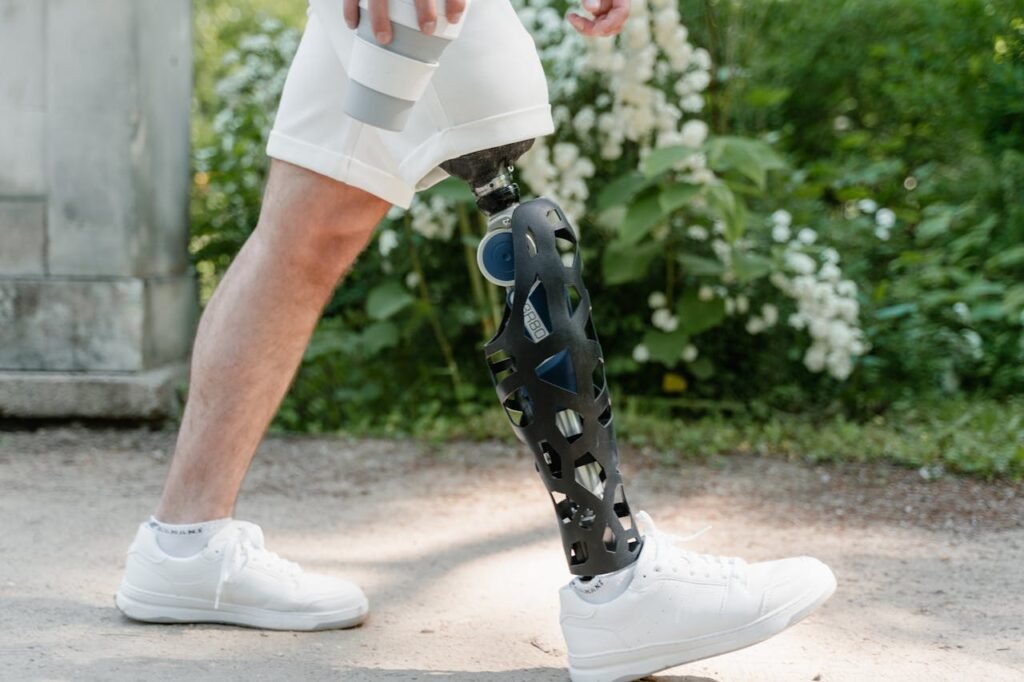
Beyond individual limb replacements, full-body prosthetic exoskeletons are emerging as the next major advancement in human mobility. Unlike standalone prosthetic limbs, exoskeletons will provide enhanced strength, endurance, and agility by integrating AI-driven support systems across the entire body.
These exoskeletons will feature high-speed AI-powered motion control, allowing users to run faster, jump higher, and carry heavy loads without fatigue. They will also use energy-recycling mechanisms, converting kinetic energy into power to extend battery life and improve movement efficiency.
By 2030, full-body prosthetic exoskeletons will be widely used in industries like defense, athletics, and rehabilitation, allowing individuals to push beyond natural human limits while maintaining full mobility and safety. These technologies will redefine physical labor, healthcare, and even extreme sports, enabling greater human performance in everyday life and beyond.
10. The Role of Brain-Machine Interfaces in Group Coordination
Future prosthetic technology will not only enhance individual abilities but also enable group coordination through brain-machine interfaces (BMIs). Imagine a world where multiple prosthetic users can synchronize their movements in real time, enhancing team-based activities like sports, rescue operations, and even military strategy.
Through neural-linked prosthetics, users will be able to share movement data and react to each other’s actions almost instantly, creating fluid, synchronized interactions. This will be particularly valuable in robotics-assisted teamwork, where humans and machines collaborate seamlessly to perform tasks that require precision and coordination.
By 2030, brain-machine interfaces will enable prosthetic users to interact with both human teams and robotic systems effortlessly, leading to a new level of connected intelligence and movement optimization.
11. The Ethical Debate: Should Prosthetic Enhancements Be Regulated?
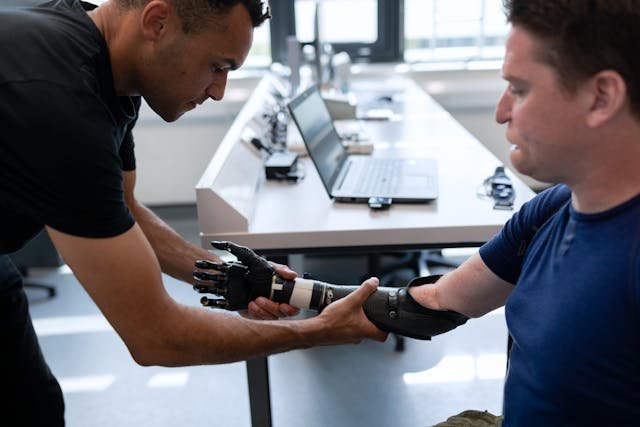
As prosthetic limbs evolve beyond restorative devices and become performance-enhancing tools, important ethical questions will arise. If prosthetics surpass human biological limits, should their use be regulated in professional sports, workplaces, and competitive environments?
Some argue that enhanced prosthetic technology could create an unfair advantage, particularly in athletics and high-skill professions. Others believe that human augmentation is the next natural step in evolution, and that society should embrace these advancements rather than restrict them.
By 2030, governments, scientists, and industry leaders will need to establish new policies to address the ethics of prosthetic augmentation, ensuring that technology remains accessible, fair, and beneficial to all while preventing potential misuse.
12. The Psychological Impact of Superhuman Prosthetic Abilities
Beyond the physical enhancements, prosthetic augmentation will also affect human identity, psychology, and social interactions. With technology allowing users to exceed natural human abilities, how will society perceive individuals with enhanced prosthetics?
Studies suggest that body augmentation can change self-perception, making users feel more confident and empowered. However, it could also create psychological challenges, as individuals navigate a world where they are fundamentally different from non-augmented humans.
By 2030, prosthetic psychology will become an important field, helping individuals adapt to their enhanced capabilities, ensuring that prosthetic users fully embrace their new abilities without psychological stress or social stigma.
13. Space Exploration and Extreme Environments: The Ultimate Test for Prosthetic Enhancements
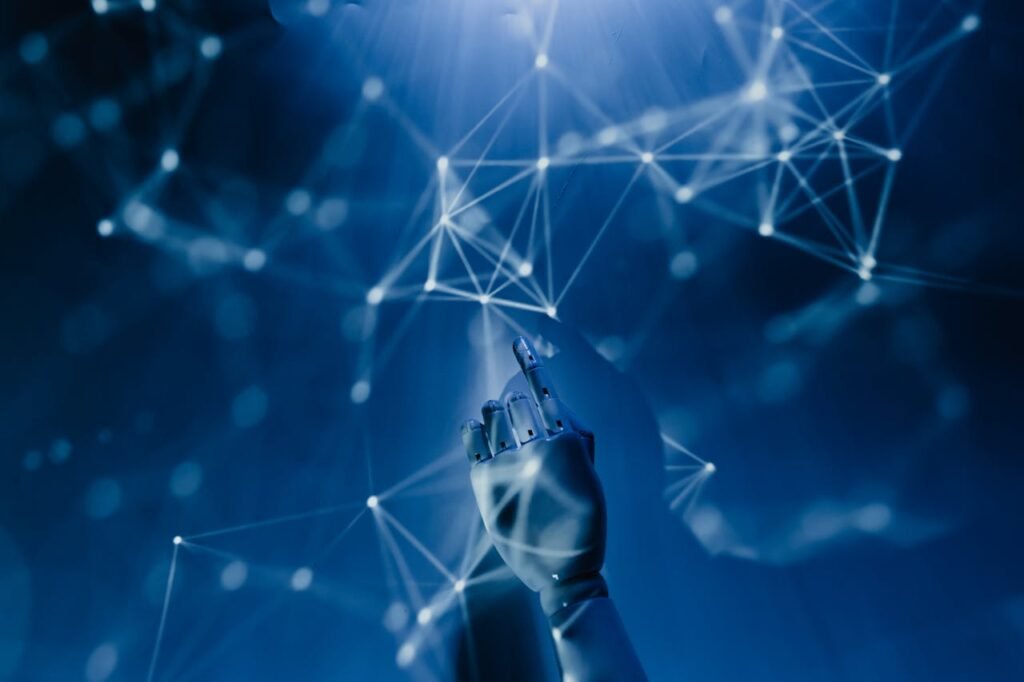
One of the most exciting applications for prosthetic enhancements is space travel and extreme environment exploration. Traditional human bodies are limited by oxygen requirements, muscle fatigue, and sensitivity to temperature and pressure changes. However, enhanced prosthetic technology could allow humans to thrive in conditions that were once impossible.
Future prosthetic limbs designed for space missions will feature radiation-resistant materials, oxygen-independent power sources, and AI-assisted movement stability, ensuring astronauts can perform complex tasks without the physical limitations of biological limbs.
By 2030, prosthetic users may be among the first to explore deep space, adapting to extraterrestrial environments more efficiently than unmodified humans, proving that technology can expand not just individual potential, but also the future of human exploration itself.
14. The Role of Prosthetic Enhancements in Shaping the Future of Humanity
As prosthetic technology advances, the line between human and machine will continue to blur, leading to a new era of human evolution. Augmented humans could become the next step in civilization, redefining work, entertainment, communication, and physical ability in ways we can only imagine today.
The debate will no longer be about whether prosthetic technology should restore function, but how far it should go in expanding human capability. Will society fully embrace prosthetic enhancements, or will there be resistance to merging biology with technology?
By 2030, the world will need to make decisions about the role of prosthetic augmentation in human progress, shaping policies, social structures, and ethical boundaries for the future of enhanced mobility, intelligence, and sensory perception.
Final Thoughts: A New Era of Human Potential
The next generation of prosthetic enhancements is not just about restoring function—it’s about expanding human potential beyond natural limits. With superhuman strength, advanced sensory perception, AI-driven reflexes, and full neural integration, prosthetic users will be able to achieve things that even the most capable biological bodies cannot.
By 2030, the idea of prosthetic limbs being “disabilities” will be completely outdated. Instead, they will be seen as cutting-edge enhancements, allowing users to push beyond human physical, sensory, and cognitive limits. This is not just the future of prosthetic technology—it’s the future of what it means to be human.
At Robobionics, we are dedicated to driving this evolution, ensuring that prosthetic users experience the most advanced, life-enhancing technologies available. If you are ready to step into the next frontier of human capability, book a free demo with Robobionics today and discover how the future of prosthetic innovation is redefining what’s possible.



